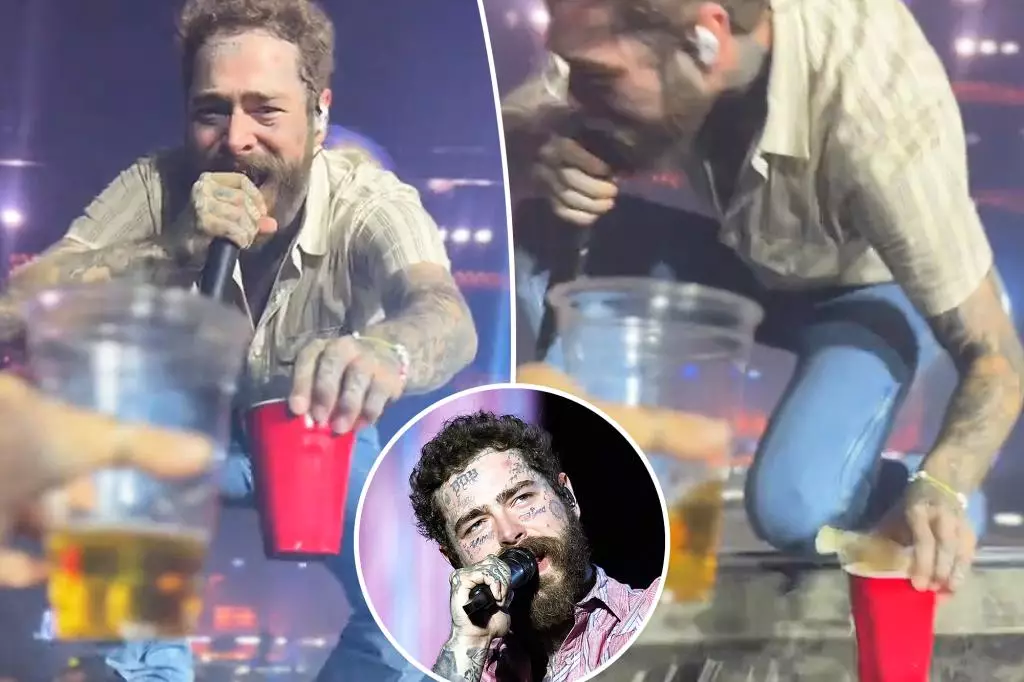Live music is a spectacle of energy, chaos, and raw emotion. For stars like Post Malone, the thrill of engaging directly with fans often comes with inherent risks. Malone’s recent stage fall in Glendale isn’t just a humorous viral clip; it exposes the perilous nature of performing live at the highest level. From unsteady platforms to unforeseen obstacles, the environment of a big concert can rapidly turn from exhilarating to hazardous. Such incidents serve as stark reminders that even well-established artists are vulnerable to physical mishaps that could endanger their well-being.
The allure of the rockstar lifestyle often masks the underlying dangers performers face. During a seemingly routine toast to fans, Malone’s fall brought to light how unpredictable stage setups can be. It’s easy to romanticize concerts as seamless displays of talent, but behind the scenes, meticulous planning and safety protocols are often overlooked or insufficient. What happened to Malone underscores the importance of designing stages that prioritize artist safety, especially when performers are actively engaging with the audience. This isn’t merely about avoiding embarrassment; it’s about preserving health and ensuring performers can continue creating music without risking permanent injury.
The Consequences of Overconfidence and Stage Design Flaws
Malone’s fall was not just a slip—it was a testament to the combination of overconfidence and potential shortcomings in stage design. His attempt to connect with a fan by raising a cup at the edge of the stage was a moment of genuine artist-fan interaction. Yet, the sudden loss of footing reveals how exposure to such risky moments without adequate safety measures can lead to accidents. The fan’s comment, jokingly saying “I didn’t mean to almost break your back,” illustrates how such incidents are often met with both concern and humor, but beneath that lies a serious issue: the need for safer performance environments.
Stage design must constantly evolve to prevent these accidents. The recurring theme of Malone falling on stage suggests failures in either planning or execution. Clearly, the ledge’s instability or lack of proper barriers contributed directly to his mishap. When artists are frequently performing in high-energy environments, even a slight miscalculation can lead to dangerous falls. The industry needs to prioritize safer staging, considering not just aesthetic appeal but also the physical safety of performers. Ultimately, such incidents question the standards of concert staging and call for stricter regulations — not just for protecting the artists but for maintaining the integrity of live performances.
The Resilience of a Rockstar Amidst Stage Mishaps
Post Malone’s willingness to keep going despite injuries illustrates the gritty resilience associated with modern stars. His transparency about receiving pain medication and bruised ribs shows a level of honesty rare in showbiz, where artists often hide discomfort to appear invincible. Malone’s attitude reflects a determination that often defines the persona of a resilient performer: acknowledging the risks while choosing to press forward for the love of fans and music.
His previous fall during the “Circles” performance in St. Louis also reveals a pattern — the grittiness to recover and persist despite setbacks. Rather than retreat or cancel shows, Malone’s approach emphasizes endurance and dedication. This attitude resonates deeply with fans, reinforcing the notion that behind the glitz and glamour are real people facing real risks. Malone’s openness about injuries and recovery fosters a sense of authenticity, strengthening the emotional connection between artist and audience. It also forces the industry to consider how to better protect these performers, ensuring that their passion doesn’t come at the cost of their health.
The Bigger Picture: Safety, Risk, and the Future of Live Music
Malone’s onstage tumbles prompt broader questions about the future of live performances and artist safety. As concerts grow in scale and spectacle, the pressure to deliver unforgettable moments intensifies. But at what cost? Is the pursuit of viral moments and intensified audience engagement risking the health of performers? Malone’s experiences argue that the industry must strike a balance — captivating shows should not come at the expense of safety protocols that are often overlooked during elaborate stage setups.
Furthermore, Malone’s incidents shine a light on a significant industry issue: safety standards are often reactive rather than proactive. The recurring nature of such accidents suggests a systemic neglect to prioritize artist welfare during the design and execution phases of concert staging. Creating safer environments not only benefits performers but also enhances the overall quality of live music. Audience members participate in these events expecting a spectacle, but they also deserve to see their icons perform without risking injury. The future of live music depends on embracing innovative, safer stage designs and fostering a culture that values the health of its stars just as much as securing memorable moments.
In essence, Malone’s misadventures serve as uncomfortable yet necessary lessons. They challenge promoters, stage designers, and artists themselves to rethink what safety in live entertainment should look like. As the industry evolves, so too must the standards that safeguard those who dedicate their lives to entertaining millions.

